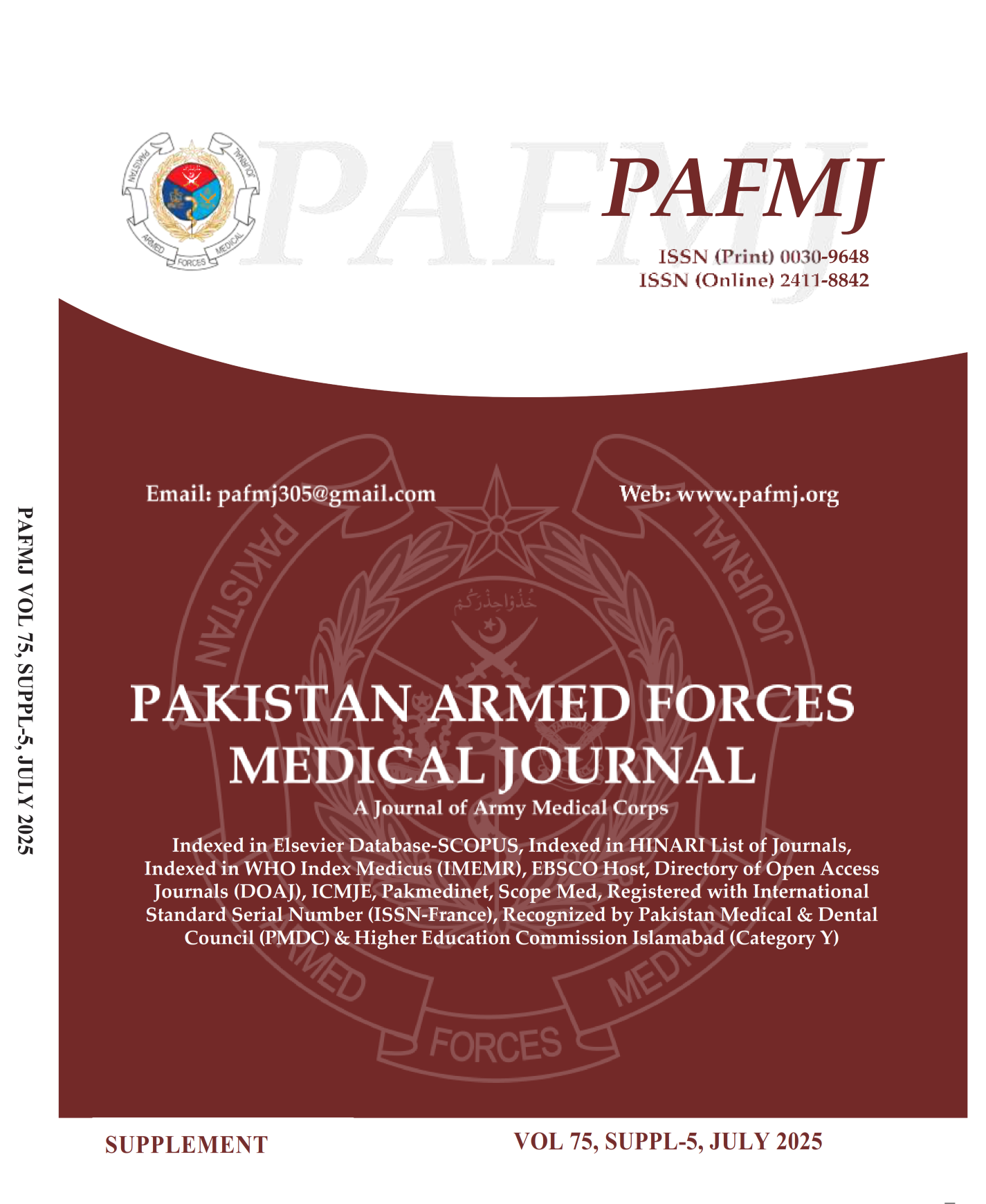Impact of Intervention on Healthcare Waste Management in a Reference Laborator
DOI:
https://doi.org/10.51253/pafmj.v75iSUPPL-5.10256Keywords:
Healthcare, Intervention, Knowledge, Practice, Training, Waste management.Abstract
Objective: To assess the effect of interventions on knowledge and practices of healthcare staff regarding healthcare waste management, in the department of Microbiology, Armed Forces Institute of Pathology, Rawalpindi.
Study Design: Quasi-experimental study
Place and Duration of study: Department of Microbiology, Armed Forces Institute of Pathology, Rawalpindi Pakistan, from July-December 2022
Methodology: This study was conducted over 33 participants including laboratory technologists, sanitary workers and Medical laboratory technology (MLT) students. The baseline knowledge and practices were checked by using an “Awareness questionnaire” and an “Observation checklist” respectively. Interventions included lectures, posters and on-spot checks. The same questionnaires were used to assess the post-intervention knowledge and practices. The pre-and post-intervention awareness scores were compared using and a p-value of <0.05 was considered statistically significant.
Results: Out of total 33 participants, 22(67%) were males and 11(33%) were females. An improvement in the knowledge and practices of the participants was noted. The improvement in knowledge between the pre and post-intervention awareness scores was found to be statistically significant with a p-value of <0.001. The on-spot practices assessed through an observation checklist revealed that pre-intervention percentage scores ranged from 38-83% while the post-intervention percentage scores ranged from 83-100%, in the nine sub-sections of the Microbiology Department.
Conclusion: The three interventions, including training, display of posters and spot checks resulted in a statistically significant improvement in the awareness and marked improvement in practices of most of the laboratory staff regarding implementation of waste management policy
Downloads
References
1. Kwikiriza S, Stewart AG, Mutahunga B, Dobson AE, Wilkinson E. A Whole Systems Approach to Hospital Waste Management in Rural Uganda. Front Public Health 2019; 7: 136.
http://doi.org/10.3389/fpubh.2019.00136
2. Sapkota B, Gupta GK, Mainali D. Impact of intervention on healthcare waste management practices in a tertiary care governmental hospital of Nepal. BMC Public Health 2014; 14: 1005. http://doi.org/10.1186/1471-2458-14-1005
3. Ezeudu OB, Ezeudu TS, Ugochukwu UC, Tenebe IT, Ajogu AP, Nwadi UV, et al. Healthcare Waste Management in Nigeria: A Review. Recycling 2022; 7(6): 87.
https://doi.org/10.3390/recycling706008
4. Selvan Christyraj JRS, Selvan Christyraj JD, Adhimoorthy P, Rajagopalan K, Nimita Jebaranjitham J. Impact of biomedical waste management system on infection control in the midst of COVID-19 pandemic. The Impact of the COVID-19 Pandemic on Green Societies: Environmental Sustainability. 2021:235-626. DOI:10.1007/978-3-030-66490-9_10
5. Carnero MC. Waste segregation FMEA model integrating intuitionistic fuzzy set and the PAPRIKA method. Mathematics 2020; 8(8): 1375. https://doi.org/10.3390/math808137
6. Chisholm JM, Zamani R, Negm AM, Said N, Abdel Daiem MM, Dibaj M, et al. Sustainable waste management of medical waste in African developing countries: A narrative review. Waste Manag Res 2021; 39(9): 1149-1163.
http://doi.org/10.1177/0734242X211029175
7. Karija MK, Shihua QI, Lukaw YS. The impact of poor municipal solid waste management practices and sanitation status on water quality and public health in cities of the least developed countries: The case of Juba, South Sudan. Int J Appl Sci Technol 2013; 3(4): 87-99.
https://www.ijastnet.com/journals/Vol_3_No_4_April_2013/11
8. Aung TS, Luan S, Xu Q. Application of multi-criteria-decision approach for the analysis of medical waste management systems in Myanmar. J Clean Prod 2019; 222: 733-45.
http://doi.org/10.1016/j.jclepro.2019.03.049
9. Gizalew Snr E, Girma Snr M, Haftu Snr D, Churko C, Girma Snr Z. Health-care Waste Management and Risk Factors Among Health Professionals in Public Health Facilities of South Omo Zone, South West Ethiopia, 2018. J Healthc Leadersh 2021; 13: 119-128. http://doi.org/10.2147/JHL.S300729
10. Letho Z, Yangdon T, Lhamo C, Limbu CB, Yoezer S, Jamtsho T, et al. Awareness and practice of medical waste management among healthcare providers in National Referral Hospital. PLoS One 2021; 16(1): e0243817.
http://doi.org/10.1371/journal.pone.0243817
11. Kumar R, Somrongthong R, Ahmed J. Impact of waste management training intervention on knowledge, attitude and practices of teaching hospital workers in Pakistan. Pak J Med Sci 2016; 32(3): 705-10. http://doi.org/10.12669/pjms.323.9903
12. Padmanabhan KK, Barik D. Health Hazards of Medical Waste and its Disposal. Energy from Toxic Organic Waste for Heat and Power Generation. Woodhead Publishing 2019: 99–118.
http://doi.org/10.1016/B978-0-08-102528-4.00008-0
13. Bansal K. Hospital waste management and environment problems in India. Journal of Pharmaceutical Negative Results 2022: 3390-3396.
https://www.pnrjournal.com/index.php/home/article/view/5135
14. Satawa MA. Types of biomedical waste management and factors associated with biomedical waste management practices among healthcare personnel at Mbagathi Hospital Nairobi County, Kenya (Doctoral dissertation, JKUAT-COHES).
http://localhost/xmlui/handle/123456789/5296
15. Chen C, Chen J, Fang R, Ye F, Yang Z, Wang Z, et al. What medical waste management system may cope with COVID-19 pandemic: Lessons from Wuhan. Resour Conserv Recycl 2021; 170: 105600. http://doi.org/10.1016/j.resconrec.2021.105600
16. Ashtari A, Sadegh Tabrizi J, Rezapour R, Rashidian Maleki M, Azami-Aghdash S. Health Care Waste Management Improvement Interventions Specifications and Results: A Systematic Review and Meta-Analysis. Iran J Public Health. 2020; 49(9): 1611-1621.
http://doi.org/10.18502/ijph.v49i9.4074
17. Robat DS, Sany SBT, Siuki HA, Peyman N, Ferns G. Impact of an Educational Training on Behavioral Intention for Healthcare Waste Management: Application of Health Action Model. Community Health Equity Research & Policy 2022; 42(3): 299-307. http://doi.org/10.1177/0272684X20982595
18. McKeon, E.G.Testing the Effectiveness of Interventions on Waste Management Behavior in University Sorority Houses 2014. https://nature.berkeley.edu/classes/es196/projects/2014final/McKeonE_2014.pdf
Downloads
Published
Issue
Section
License
Copyright (c) 2025 Javeria Qasim, Maria Mushtaq Gill, Irfan Ali Mirza, Muhammad Omair Riaz, Sakeenah Hussain Naqvi, Rabia Sajjad

This work is licensed under a Creative Commons Attribution-NonCommercial 4.0 International License.















